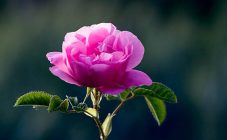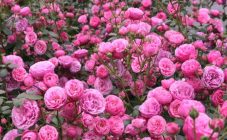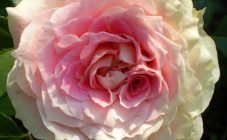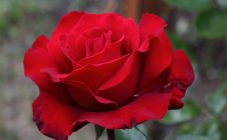Content:
The Rhapsody in Blue rose is a scrub rose. It is unlike any other rose, has beautiful purple-violet buds and does not quite match its name, which is translated from English as "blue rhapsody". Although in some cases the flower does take on a blue tint. Usually, such a Rhapsody in Blue rose becomes at dusk.
Rose Blue Rhapsody is the bluest on the planet.
General information about scrub roses
Translated from English, the word "shrub" means "bush". Initially, the group called "rose scrub" included roses that have a tall bush and abundant flowering. Over time, hybrids that were not included in other groups began to be included in this group.
Scrub rose has its own differences that make it special compared to other varieties of shrub roses. These include:
- blooms that are repeated or long lasting and abundant. The buds can grow in early summer and appear one after the other until the end of the autumn period;
- in this group of plants, the inflorescences can be very diverse and have different colors and shapes of buds, ranging from classic options to hybrid terry;
- most of the scrub roses have a rich and unforgettable aroma;
- shrub roses are highly resistant to frost and most diseases that are characteristic of them;
- these plants do not require special care and growing conditions, being an unpretentious variety;
- most of the scrub roses have voluminous bushes up to 2 meters in height.
The history of the creation of the Blue Rhapsody variety
Rhapsody blue - rose, named after one of the best pieces of music by the American composer George Gershwin "Rhapsody in the Blues", which was first performed on February 12, 1924.
The rose variety was obtained by crossing Summer Wine x (International Herald Tribune x ((Blue Moon x Montezuma) x (Violacea x Montezuma))). It was received in 1999 under the name Fantasia, and presented in 2002 under the famous name Rhapsody in Blue.
Description of the characteristics and features of the Rhapsody inblue rose
Rosa Rapsody in blue is a park. Its purple-violet flowers are not large and have a diameter of 5-6 cm. Being in the shape of a bud, the flower has the shape of a cone, and after dissolution takes the shape of a flat bowl. In the open middle, bright golden stamens are visible. Closer to the center, the petals are white. Each flower contains 20-25 petals. 3 to 5 buds bloom on one stem. In different periods of flowering, the color scheme may change. The color is also influenced by the weather and lighting of the place where the flower is planted.
The bush is very tall and can reach a height of 150 cm and more. This must be taken into account when planting, since all flowers and plants that will be planted behind it will not be visible.
Rhapsody blues rose has quite abundant foliage with not very large leaves. The diameter of the bush reaches about 70 cm.Taking into account its height, it is quite compact, and not spreading.
Rose Blue Rhapsody blooms for a long time and profusely twice a season. The first bloom begins in June.The rose rests for one month and then begins to bloom again. The petals fall off quickly enough. The aroma of the flower is bright and spicy.
The terry of the plant is not large, slightly more than that of the dog rose. The flowers are not afraid of rain and they are on the bush from 3 to 5 days.
Rose has good disease resistance.
Rhapsodi in blue rose has an average frost resistance and winters safely within a temperature not exceeding −23 degrees. At lower temperatures, the flower needs to provide good shelter for the winter.
Features of caring for a Rhapsody inblu rose
Rhapsody blue rose needs proper care. It is better for her if she is in partial shade, since there is a risk that the petals can get burned under the scorching sun, as well as fade and lose their original color. In partial shade, all flowers will have the same color. The plant also needs good air circulation, which will help fight harmful insects and diseases. It is undesirable to grow a flower in the shade and low places on the site, since it is colder there and the plant can get sick. It should grow in a dry place that is not swampy.
During the summer, the flower must be fertilized with fertilizers containing nitrogen, which has a good effect on the growth of the green bush and on flowering. The soil must also allow air to pass through well so that the plant can receive the necessary moisture and oxygen. The flower grows well in soil that is rich in humus and on loamy soil.
The clay soil, before planting a rose in it, must be improved by adding humus, compost. Or you can add peat or sand.
You should not plant a flower in sandy soil either, since it is infertile, moisture does not linger, and it gets very hot in hot weather. It is necessary to add clay to it, as well as sod soil, humus or compost from peat and manure.
The roots of the plant are deep in the ground, and if the groundwater is high, then, due to high humidity, the rose can hurt with black spot. For the favorable growth of the flower, the groundwater should be at a level of at least 100 cm.
Planting a Rhapsody in Blue rose in the middle lane and more northern regions begins in April or May. Planting in the fall is also permissible, but this must be done quickly so that the flower can have time to take root.
Rhapsody in blue can be planted separately and also looks good as a hedge. In this case, it is planted obliquely to the support at an angle of 30 degrees. In the event that the flower grows near the house, then it is important to indent it. This is necessary so that the water that flows from the roof does not erode the roots of the plant.
Before planting, a hole is dug with a depth of about 60 cm. At the bottom of the hole, drainage is poured with a thickness of at least 10 cm in the form of small pebbles, crushed stone or gravel. After drainage, rotted manure or compost is placed, at least 10 cm thick. Then all this is covered with earth 10 cm thick in the form of a dome.
Before planting a flower, it must be placed in a special agent that stimulates root growth. The remedy helps the flower to root better and to transfer planting.
Rose has a high resistance to disease, but it still requires disease prevention measures. The flower has good resistance to powdery mildew and black spot.
When planting together with other flowers on the site, you need to choose plants that are below the Blue Rhapsody rose so that its beautiful flowers are visible.
At temperatures above -7 degrees, the rose does not need to be covered. It is necessary to make a shelter for the flower when a steady cold snap begins.
The shelter is made from fir spruce branches. A solid base of fortifications is made over the shoots, wrapping it with special material. In the first months of spring, the frame is opened on the sides for the purpose of airing.
Rosa Rhapsody blues is propagated by cuttings. After the first wave of flowering of strong young bushes has passed, cuttings begin to prepare them.
Advantages and Disadvantages of Blue Rhapsody Rose
Rose Rhapsody in Blue has such advantages as:
- unusual unique colors of flowers;
- unpretentious care;
- abundance and consistency of flowering;
- the bush has good growth;
- high resistance to rain;
- pleasant aroma;
- strong resistance to powdery mildew and black spot;
- have good winter resistance.
Among the disadvantages are:
- flowers fly around quickly;
- the color of the rose is influenced by its location, which some of the flower growers do not like.
When planting a Blue Rhapsody rose, you need to remember that the dark color of its flowers can overshadow other flowers that have pastel or light shades.















